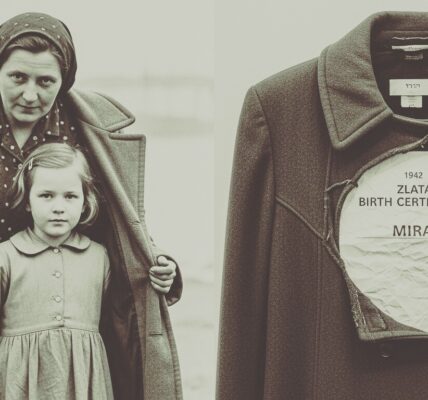Moshe’s Last Prayer – An Eternal Echo in the Flames of Treblinka
In 1943 , in the midst of a world engulfed by terror, a skeletal old man stood tall, despite the beatings, despite the hunger, despite the deadly shadow of the chimneys. His name was Moshe , a respected rabbi, a man whose faith had survived humiliation, deportation, and forced exile. There, in the Treblinka extermination camp , where the black smoke of the crematoria covered the sky, he uttered a prayer that would transcend horror: the Shema Yisrael .
This heartbreaking yet dignified scene was recounted by a few survivors. Today, it embodies what we call a memorial journey , a dive into the depths of the human soul in the face of barbarity. But before arriving at this precise moment, we must understand what Treblinka represented , one of the darkest places in the history of the Second World War .
Treblinka wasn’t just a camp; it was a machine designed to erase lives. Every day, thousands of men, women, and children were deported there, often crammed into cattle cars, deprived of water and air. Upon arrival, they were led to believe they were going to wash. In reality, they were directed to the gas chambers. Within minutes, muffled screams, pleas, and whispers disappeared into silence.
Yet even in this place where humanity seemed to have disappeared, there were moments of resistance. Not just armed revolts, but tiny gestures: sharing a piece of bread, protecting a child, or, like Moshe, reciting a prayer. These gestures, invisible to the executioners, represented an act of faith and resilience .
Moshe était vieux, affaibli, dépouillé de ses vêtements, de ses biens, de son nom presque. Pourtant, il lui restait une richesse que personne ne pouvait lui arracher : sa mémoire et sa prière. Ses lèvres desséchées murmuraient le Shema Israël, cette proclamation de l’unité divine que chaque Juif récite au lever et au coucher, mais aussi au seuil de la mort.
Un garde, amusé par ce qu’il percevait comme une absurdité, ricana :
— Que dis-tu, mon vieux ?
Alors, Moshe leva son regard, ses yeux brillants de foi malgré l’épuisement. Il répondit, d’une voix calme :
— Le Shema. Pour la dernière fois.
Ces mots, simples, portaient en eux l’écho de siècles d’histoire, de traditions, de chants et de souffrances. Ils étaient l’ultime affirmation que, même dans la souffrance extrême, un homme pouvait rester libre dans son âme.
Quelques minutes plus tard, Moshe disparut dans la chambre à gaz, comme tant d’autres. Mais les survivants racontèrent qu’à cet instant précis, lorsqu’une nouvelle fumée s’éleva du crématoire, elle semblait transporter la prière de Moshe vers le ciel. Cette image bouleversante est restée gravée dans les mémoires : la fumée, qui symbolisait la mort, devenait aussi le véhicule d’un message spirituel.
C’était une façon de dire : « Vous pouvez éteindre nos corps, mais vous n’éteindrez pas notre foi, ni notre dignité. »
Aujourd’hui, quand nous parlons de mémoire collective, l’histoire de Moshe trouve une place essentielle. Elle incarne l’héritage spirituel transmis par ceux qui n’ont pas survécu, mais dont la voix résonne encore. Dans chaque récit, chaque témoignage, chaque voyage vers un ancien camp de concentration, le souffle de cette prière refait surface.
C’est pourquoi visiter des lieux comme Treblinka, Auschwitz ou Sobibor ne relève pas seulement de l’histoire de la Seconde Guerre mondiale. C’est un voyage mémoriel qui invite chacun à réfléchir aux valeurs universelles : la dignité humaine, la liberté de conscience, la force de l’espérance.
Pourquoi revenir sans cesse sur ces récits ? Parce que l’oubli est le plus grand danger. L’oubli ouvre la porte à la banalisation du mal. Chaque génération doit entendre l’histoire de Moshe et de tant d’autres. Dans un monde où l’information circule vite, où le bruit médiatique submerge, il est vital de préserver ces récits, de les inscrire dans la pierre numérique du XXIᵉ siècle.
La littérature, les documentaires, les voyages mémoriels, les musées et les commémorations sont autant de moyens de maintenir vivante cette flamme fragile.
Moshe’s story doesn’t end in 1943. It still speaks to us today. It reminds us that in the darkest darkness, man retains a spark within him that no dictatorship, no machine of death, can extinguish.
Resilience has become a buzzword in our modern society, often used in the worlds of personal development, management, and psychology. But in Moshe’s context, it takes on its full meaning: resilience is finding the strength to remain true to oneself, even when all seems lost.
Every year, thousands of visitors from all over the world travel to Treblinka. This is not just any tourism. It is a spiritual quest, a journey of remembrance that shakes, shakes, and transforms.
For historians, teachers, and families alike, this story is a call to vigilance. It encourages us to convey the importance of peace, respect, and humanity .
The last image of Moshe, his hands clasped, his lips still murmuring a prayer, remains a timeless lesson. In the camp designed to reduce man to nothing, he proved that the human spirit could still rise.
His act of faith became a kind of eternal flame, a beacon in the darkness. And even today, in a world wracked by crises, conflicts, and violence, this story resonates like a warning: Let us never let inhumanity triumph.
In retracing Moshe’s story, we are not just telling the story of one man. We are highlighting the power of faith , the power of collective memory , and the need to preserve universal values .
This profoundly human story shows us that even in the death camps, where man was reduced to his simplest expression, there remained a force capable of transcending terror. This force is faith and resilience .
Thus, Moshe’s final prayer does not just belong to the past. It accompanies us, like a breath that passes through time, reminding us that the human spirit can survive all storms, even the darkest.






